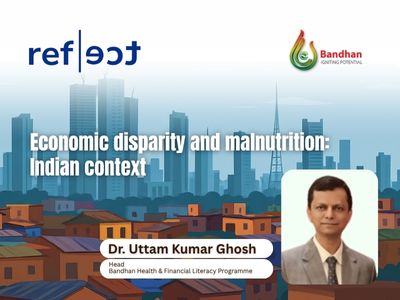Dr. Uttam Kumar Ghosh

India’s strong economic growth couldn’t reduce malnutrition significantly, due to deep-seated economic inequality, gender disparity, and poor sanitation. This economic inequality leads to vast differences in nutritional status especially among young children, where the poor are most sufferers, but even wealthier households may see malnutrition in the form of obesity due to over nutrition. UNICEF reports that, India faces significant challenges with child hunger, with a high number of children “severe child food poverty” and a widespread problem of “hidden hunger” (micronutrient deficiency) among adolescents. Lack of an adequate balanced diet during early childhood may cause impaired growth and cognitive development.
India, the largest democratic country in the world embodied diverse social cultures in terms of religion, race, ethnicity, languages, environment etc. It’s one of the most populous countries in the world having around 140 crore population with so many social challenges. Since independence the Indian economy has made tremendous progress but the holistic development is uneven in different territories especially between urban and rural. India’s economy is one of the fastest-growing in the world, with a GDP of about 4 trillion US dollars. At present India is the 5th largest economy after the United States, China, Japan, and Germany but its per capita nominal GDP (2,818 US dollar as per IMF, 2025) is significantly low, placing it at 143 in world ranking. If the growth continues, India is projected to become the fourth-largest economy by 2025 and the third-largest by 2027-2029. But the concern issue is that India bears some of the highest levels of income inequality in the world, with a small percentage of the population holding a disproportionately large share of national income. The richest 1% of this country hold over 40% of the nation’s wealth, while the bottom 50% own only about 3%. Factors contributing to this include the rural-urban divide, a significant gender pay gap, and wealth concentration among a small elite.
Despite many efforts taken by the central and state governments aligning with various Sustainable Development Goals (SDGs) the malnutrition issue especially among the under-5 children is still a serious public health concern. World’s largest nutrition initiatives like Integrated Child Development Scheme (ICDS) and Mid-day Meal programme catering millions of children with supplementary foods, but the situation didn’t improve significantly. UNICEF’s work in India includes supporting government efforts to reduce stunting and wasting through programs like the National Nutrition Mission (POSHAN Abhiyaan). As per the National Family Health Survey-5 (NFHS), prevalence of underweight, stunting and wasting among under-5 children are 32.1%, 35.5%, and 19.3% respectively along with 3.4% are over-weight. Additionally, anaemia affects a large percentage of the population, with 67% of under-5 children and 57% of women and 25% of men (15-49 age group) being anaemic. Increased prevalence of anaemia among women than men may be due to iron loss during menstruation, childbirth, coupled with nutrition deficiencies, poor dietary intake of iron rich food and inequitable gender norms. Again, various micronutrient deficiencies, such as iron, folic acid, and vitamin B12, are also highly prevalent among them. Though the condition is improving, it is still far behind compared to high income developed countries. Global Hunger Index (GHI) in 2025 (102nd out of 123 countries) clearly indicates the economic disparity in India. It’s GHI score is 25.8, which is categorized as “serious” according to the GHI Severity of Hunger Scale.
Though there is a significant reduction in poverty, other social development indicators like health, nutrition, and education lag behind economic growth till date. If we consider the development of India in terms of Human Development Index (HDI) the position is not at all convincing. India is ranked 130th out of 193 countries in the 2025 Human Development Index (HDI) report, according to the United Nation Development Programme (UNDP). The report shows India’s HDI value increased to 0.685 in 2023, up from 0.676 in 2022, which places it in the “medium human development” category moving closer to the threshold for high human development (HDI ≥ 0.700) while Iceland ranked 1st and South Sudan is in last position. The components of the Human Development Index (HDI) are life expectancy at birth, education, and standard of living. Education is measured by two indicators: the mean years of schooling for adults above the 25 years age group and the expected years of schooling for children. Standard of living is measured by gross national income (GNI) per capita. Social development in terms of health, education and income are the prerequisite to HDI.
HDI rank of India fluctuates over the last decade (between 129 -135) but data reveals steady improvement in HDI values. It means though India is moving forward but the rest of the world moves faster than India. India has remained in the “medium human development” category throughout the last 10 years and at present it’s nearing the threshold for the “high human development” category (HDI ≥ 0.700). But fallacy is, when adjusted for inequality, India’s IHDI value is significantly lower than its HDI value. For India, the loss due to inequality is more than 30%, due to factors like socio-cultural disparities and gender inequality.
Changes in HDI value and indicators between 2022-2023:
| Key Data | 2022 | 2023 |
| Life Expectancy (years) | 71.7 | 72 |
| Expected Years of Schooling | 12.96 | 12.95 |
| Mean Years of Schooling | 6.57 | 6.88 |
| Gross National Income Per Capita (US dollar 2021 PPP) | 8475.68 | 9046.76 |
According to the World Bank, India has lifted over 171 million people out of poverty (living on less than $2.15 a day, based on 2017) between 2011-12 and 2022-23. The extreme poverty rate has fallen from 16.2% to 2.3%. Rural poverty decreased from 18.4% to 2.8% and urban poverty declined from 10.7% to 1.1% during this time. Uttar Pradesh, Madhya Pradesh, Maharashtra, West Bengal and Bihar contributed to two thirds of the total reduction.
Non-Government Organizations (NGOs) in India are playing a crucial role in social development by enhancing citizens’ capabilities through better access to education, healthcare, skill training and housing, thereby addressing social factors like poverty and inequality. Additionally, they serve as a vital link between communities and the government, advocating for policy changes and acting as “think tanks” to develop innovative solutions. The uneven development in India is a complex issue driven by regional disparities, with wealthier states in south, west and northeast contrasting with poorer states in the north, centre and east. Addition to this disparities between urban and rural, race and religion needs to be abolished, otherwise reaching to the developed category country as per HDI will be like a mirage to everyone except those 1% of Indians. It needs genuine political will and commitment of the stakeholders instead of appeasement politics to retain the public opinion in the polls. The role of central and state government is crucial here for holistic development of 140 crore population in India.
Nobel Laureate Professor Amartya Sen defines social development as “equality of social opportunities”. His broader work, “Development as Freedom,” elaborates that development is the process of expanding human freedoms, which include social opportunities like access to education and healthcare, alongside political freedoms, economic facilities, transparency guarantees, and protective security. It needs further special attention in taking appropriate measures to reduce socio-economic disparities in combating malnutrition, otherwise India will suffer from lack of skilled manpower in future. For pregnant women, malnutrition increases the risk of complications and low birth weight, perpetuating the cycle across generations. These effects can be permanent, leading to reduced physical and economic productivity in adulthood. Children need the right foods at the right time to reach their full potential. Well-nourished children are more likely to climb the growth chart at a steady pace, learn better, play better, and develop healthy bodies and minds.




